Unraveling Aerosol and Low-Level Cloud Interactions Under Multi-Factor Constraints at the Semi-Arid Climate and Environment Observatory of Lanzhou University
Abstract
1. Introduction
2. Materials and Methods
2.1. Materials
2.2. Methods
3. Results
3.1. Vertical Distribution of Meteorological Factors and Low-Level Clouds
3.2. Relationship Between Meteorological Factors and Cloud Properties
3.3. Seasonal Variations in Aerosol Physical and Optical Properties
3.4. Cloud Properties Under Different Aerosol Absorption Regimes
3.5. ACI Under Individual Constraint
3.5.1. ACI Under PC1 Constraint
3.5.2. ACI Under LWP Constraint
3.5.3. Changes in Cloud Micro- and Macrophysical Properties
3.6. ACI Under Dual Constraints of PC1 and LWP
3.7. Impact of Aerosol Type on ACI Under Dual Constraints
- Black carbon (Figure 11a): Even under high-LWP conditions, CER remains relatively small at peak black carbon aerosol optical depth (BCAOD) values, suggesting that black carbon inhibits droplet growth despite sufficient water vapor, likely due to enhanced droplet evaporation.
- Dust aerosols (Figure 11b): Under favorable meteorological conditions, an increased dust aerosol optical depth (DUAOD) correlates with larger CER values, suggesting that dust particles may serve as effective ice nuclei that promote droplet growth through heterogeneous freezing processes [70]. However, in unfavorable meteorological conditions, dust appears to reduce CER, suggesting that the impact of meteorological conditions may outweigh the effects of dust.
- Organic carbon (Figure 11c): Similar to black carbon, higher organic carbon aerosol optical depth (OCAOD) values correspond to lower CER, especially when PC1 ranges from −0.6 to −0.3. Organic carbon can be activated as CCN, resulting in more numerous but smaller droplets.
- Sulfate aerosols (Figure 11d): A higher sulfate aerosol optical depth (SUAOD) correlates with smaller droplet sizes, particularly at low LWP, indicating that sulfate aerosols generate numerous smaller droplets by acting as CCN, thereby inhibiting droplet growth due to competition for limited water vapor.
4. Discussion
5. Conclusions
Author Contributions
Funding
Data Availability Statement
Conflicts of Interest
References
- Duveiller, G.; Filipponi, F.; Ceglar, A.; Bojanowski, J.; Alkama, R.; Cescatti, A. Revealing the widespread potential of forests to increase low level cloud cover. Nat. Commun. 2021, 12, 4337. [Google Scholar] [CrossRef] [PubMed]
- Liu, H.; Koren, I.; Altaratz, O.; Chekroun, M.D. Opposing trends of cloud coverage over land and ocean under global warming. Atmos. Chem. Phys. 2023, 23, 6559–6569. [Google Scholar] [CrossRef]
- Kamae, Y.; Watanabe, M.; Ogura, T.; Yoshimori, M.; Shiogama, H. Rapid Adjustments of Cloud and Hydrological Cycle to Increasing CO: A Review. Curr. Clim. Change Rep. 2015, 1, 103–113. [Google Scholar] [CrossRef]
- Kristjánsson, J.E.; Muri, H.; Schmidt, H. The hydrological cycle response to cirrus cloud thinning. Geophys. Res. Lett. 2015, 42, 10807–10815. [Google Scholar] [CrossRef]
- Wang, Y.X.; Yang, S.X.; Chen, G.X.; Bao, Q.; Li, J.D. Evaluating two diagnostic schemes of cloud-fraction parameterization using the CloudSat data. Atmos. Res. 2023, 282, 106510. [Google Scholar] [CrossRef]
- Naud, C.M.; Elsaesser, G.S.; Booth, J.F. Dominant Cloud Controlling Factors for Low-Level Cloud Fraction: Subtropical Versus Extratropical Oceans. Geophys. Res. Lett. 2023, 50, e2023GL104496. [Google Scholar] [CrossRef]
- Leahy, L.V.; Wood, R.; Charlson, R.J.; Hostetler, C.A.; Rogers, R.R.; Vaughan, M.A.; Winker, D.M. On the nature and extent of optically thin marine low clouds. J. Geophys. Res.-Atmos. 2012, 117, D22201. [Google Scholar] [CrossRef]
- Nuijens, L.; Serikov, I.; Hirsch, L.; Lonitz, K.; Stevens, B. The distribution and variability of low-level cloud in the North Atlantic trades. Q. J. Roy. Meteor. Soc. 2014, 140, 2364–2374. [Google Scholar] [CrossRef]
- Sun, F.; Hall, A.; Qu, X. On the relationship between low cloud variability and lower tropospheric stability in the Southeast Pacific. Atmos. Chem. Phys. 2011, 11, 9053–9065. [Google Scholar] [CrossRef]
- Murray, B.J.; Carslaw, K.S.; Field, P.R. Opinion: Cloud-phase climate feedback and the importance of ice-nucleating particles. Atmos. Chem. Phys. 2021, 21, 665–679. [Google Scholar] [CrossRef]
- Klein, S.A.; Hall, A.; Norris, J.R.; Pincus, R. Low-Cloud Feedbacks from Cloud-Controlling Factors: A Review. Surv. Geophys. 2017, 38, 1307–1329. [Google Scholar] [CrossRef]
- Twomey, S. The Influence of Pollution on the Shortwave Albedo of Clouds. J. Atmos. Sci. 1977, 34, 1149–1152. [Google Scholar] [CrossRef]
- Ramanathan, V.; Crutzen, P.J.; Kiehl, J.T.; Rosenfeld, D. Atmosphere—Aerosols, climate, and the hydrological cycle. Science 2001, 294, 2119–2124. [Google Scholar] [CrossRef]
- Saleeby, S.M.; Herbener, S.R.; van den Heever, S.C.; L’Ecuyer, T. Impacts of Cloud Droplet-Nucleating Aerosols on Shallow Tropical Convection. J. Atmos. Sci. 2015, 72, 1369–1385. [Google Scholar] [CrossRef]
- Albrecht, B.A. Aerosols, Cloud Microphysics, and Fractional Cloudiness. Science 1989, 245, 1227–1230. [Google Scholar] [CrossRef] [PubMed]
- Wang, Y.; Vogel, J.M.; Lin, Y.; Pan, B.W.; Hu, J.X.; Liu, Y.G.; Dong, X.Q.; Jiang, J.H.; Yung, Y.L.; Zhang, R.Y. Aerosol microphysical and radiative effects on continental cloud ensembles. Adv. Atmos. Sci. 2018, 35, 234–247. [Google Scholar] [CrossRef]
- McComiskey, A.; Feingold, G.; Frisch, A.S.; Turner, D.D.; Miller, M.A.; Chiu, J.C.; Min, Q.L.; Ogren, J.A. An assessment of aerosol-cloud interactions in marine stratus clouds based on surface remote sensing. J. Geophys. Res.-Atmos. 2009, 114, D09203. [Google Scholar] [CrossRef]
- Feingold, G.; Furrer, R.; Pilewskie, P.; Remer, L.A.; Min, Q.L.; Jonsson, H. Aerosol indirect effect studies at Southern Great Plains during the May 2003 Intensive Operations Period. J. Geophys. Res.-Atmos. 2006, 111, D05s14. [Google Scholar] [CrossRef]
- Costantino, L.; Bréon, F.M. Analysis of aerosol-cloud interaction from multi-sensor satellite observations. Geophys. Res. Lett. 2010, 37, L11801. [Google Scholar] [CrossRef]
- Quaas, J.; Boucher, O.; Bellouin, N.; Kinne, S. Satellite-based estimate of the direct and indirect aerosol climate forcing. J. Geophys. Res.-Atmos. 2008, 113, D05204. [Google Scholar] [CrossRef]
- Michibata, T.; Kawamoto, K.; Takemura, T. The effects of aerosols on water cloud microphysics and macrophysics based on satellite-retrieved data over East Asia and the North Pacific. Atmos. Chem. Phys. 2014, 14, 11935–11948. [Google Scholar] [CrossRef]
- Breon, F.M.; Tanre, D.; Generoso, S. Aerosol effect on cloud droplet size monitored from satellite. Science 2002, 295, 834–838. [Google Scholar] [CrossRef]
- Zhao, C.F.; Qiu, Y.M.; Dong, X.B.; Wang, Z.E.; Peng, Y.R.; Li, B.D.; Wu, Z.H.; Wang, Y. Negative Aerosol-Cloud re Relationship From Aircraft Observations Over Hebei, China. Earth Space Sci. 2018, 5, 19–29. [Google Scholar] [CrossRef]
- Twohy, C.H.; Anderson, J.R.; Toohey, D.W.; Andrejczuk, M.; Adams, A.; Lytle, M.; George, R.C.; Wood, R.; Saide, P.; Spak, S.; et al. Impacts of aerosol particles on the microphysical and radiative properties of stratocumulus clouds over the southeast Pacific Ocean. Atmos. Chem. Phys. 2013, 13, 2541–2562. [Google Scholar] [CrossRef]
- Painemal, D.; Zuidema, P. The first aerosol indirect effect quantified through airborne remote sensing during VOCALS-REx. Atmos. Chem. Phys. 2013, 13, 917–931. [Google Scholar] [CrossRef]
- Lu, C.S.; Liu, Y.G.; Niu, S.J.; Vogelmann, A.M. Observed impacts of vertical velocity on cloud microphysics and implications for aerosol indirect effects. Geophys. Res. Lett. 2012, 39, L21808. [Google Scholar] [CrossRef]
- Wang, Y.Y.; Li, Z.Q.; Zhang, Y.J.; Du, W.; Zhang, F.; Tan, H.B.; Xu, H.B.; Fan, T.Y.; Jin, X.A.; Fan, X.X.; et al. Characterization of aerosol hygroscopicity, mixing state, and CCN activity at a suburban site in the central North China Plain. Atmos. Chem. Phys. 2018, 18, 11739–11752. [Google Scholar] [CrossRef]
- Dusek, U.; Frank, G.P.; Hildebrandt, L.; Curtius, J.; Schneider, J.; Walter, S.; Chand, D.; Drewnick, F.; Hings, S.; Jung, D.; et al. Size matters more than chemistry for cloud-nucleating ability of aerosol particles. Science 2006, 312, 1375–1378. [Google Scholar] [CrossRef]
- Andreae, M.O.; Rosenfeld, D. Aerosol-cloud-precipitation interactions. Part 1. The nature and sources of cloud-active aerosols. Earth-Sci. Rev. 2008, 89, 13–41. [Google Scholar] [CrossRef]
- Koren, I.; Feingold, G.; Remer, L.A. The invigoration of deep convective clouds over the Atlantic: Aerosol effect, meteorology or retrieval artifact? Atmos. Chem. Phys. 2010, 10, 8855–8872. [Google Scholar] [CrossRef]
- Tang, J.P.; Wang, P.C.; Mickley, L.J.; Xia, X.G.; Liao, H.; Yue, X.; Sun, L.; Xia, J.R. Positive relationship between liquid cloud droplet effective radius and aerosol optical depth over Eastern China from satellite data. Atmos. Environ. 2014, 84, 244–253. [Google Scholar] [CrossRef]
- Zhang, X.; Wang, H.; Che, H.Z.; Tan, S.C.; Yao, X.P.; Peng, Y.; Shi, G.Y. Radiative forcing of the aerosol-cloud interaction in seriously polluted East China and East China Sea. Atmos. Res. 2021, 252, 105405. [Google Scholar] [CrossRef]
- Nakajima, T.; Higurashi, A.; Kawamoto, K.; Penner, J.E. A possible correlation between satellite-derived cloud and aerosol microphysical parameters. Geophys. Res. Lett. 2001, 28, 1171–1174. [Google Scholar] [CrossRef]
- Pawlowska, H.; Brenguier, J.L. Microphysical properties of stratocumulus clouds during ACE-2. Tellus B 2000, 52, 868–887. [Google Scholar] [CrossRef]
- Kant, S.; Panda, J.; Gautam, R. A seasonal analysis of aerosol-cloud-radiation interaction over Indian region during 2000–2017. Atmos. Environ. 2019, 201, 212–222. [Google Scholar] [CrossRef]
- Yuan, T.L.; Li, Z.Q.; Zhang, R.Y.; Fan, J.W. Increase of cloud droplet size with aerosol optical depth: An observation and modeling study. J. Geophys. Res.-Atmos. 2008, 113, D04201. [Google Scholar] [CrossRef]
- Fan, J.W.; Zhang, R.Y.; Li, G.H.; Tao, W.K. Effects of aerosols and relative humidity on cumulus clouds. J. Geophys. Res.-Atmos. 2007, 112, D14204. [Google Scholar] [CrossRef]
- Li, Z.Q.; Niu, F.; Fan, J.W.; Liu, Y.G.; Rosenfeld, D.; Ding, Y.N. Long-term impacts of aerosols on the vertical development of clouds and precipitation. Nat. Geosci. 2011, 4, 888–894. [Google Scholar] [CrossRef]
- Engström, A.; Ekman, A.M.L. Impact of meteorological factors on the correlation between aerosol optical depth and cloud fraction. Geophys. Res. Lett. 2010, 37, L18814. [Google Scholar] [CrossRef]
- Mauger, G.S.; Norris, J.R. Meteorological bias in satellite estimates of aerosol-cloud relationships. Geophys. Res. Lett. 2007, 34, L16824. [Google Scholar] [CrossRef]
- Kim, Y.J.; Kim, B.G.; Miller, M.; Min, Q.L.; Song, C.K. Enhanced aerosol-cloud relationships in more stable and adiabatic clouds. Asia-Pac. J. Atmos. Sci. 2012, 48, 283–293. [Google Scholar] [CrossRef]
- Wang, G.Y.; Huang, J.P.; Guo, W.D.; Zuo, J.Q.; Wang, J.M.; Bi, J.R.; Huang, Z.W.; Shi, J.S. Observation analysis of land-atmosphere interactions over the Loess Plateau of northwest China. J. Geophys. Res.-Atmos. 2010, 115, D00k17. [Google Scholar] [CrossRef]
- Huang, J.P.; Zhang, W.; Zuo, J.Q.; Bi, J.R.; Shi, J.S.; Wang, X.; Chang, Z.L.; Huang, Z.W.; Yang, S.; Zhang, B.D.; et al. An Overview of the Semi-arid Climate and Environment Research Observatory over the Loess Plateau. Adv. Atmos. Sci. 2008, 25, 906–921. [Google Scholar] [CrossRef]
- Liu, Y.; Huang, J.; Shi, G.; Takamura, T.; Khatri, P.; Bi, J.; Shi, J.; Wang, T.; Wang, X.; Zhang, B. Aerosol optical properties and radiative effect determined from sky-radiometer over Loess Plateau of Northwest China. Atmos. Chem. Phys. 2011, 11, 11455–11463. [Google Scholar] [CrossRef]
- Bi, J.R.; Huang, J.P.; Fu, Q.A.; Wang, X.; Shi, J.S.; Zhang, W.; Huang, Z.W.; Zhang, B.D. Toward characterization of the aerosol optical properties over Loess Plateau of Northwestern China. J. Quant. Spectrosc. Radiat. Transf. 2011, 112, 346–360. [Google Scholar] [CrossRef]
- Huang, J.; Minnis, P.; Yan, H.; Yi, Y.; Chen, B.; Zhang, L.; Ayers, J.K. Dust aerosol effect on semi-arid climate over Northwest China detected from A-Train satellite measurements. Atmos. Chem. Phys. 2010, 10, 6863–6872. [Google Scholar] [CrossRef]
- Widener, K.B.; Bharadwaj, N.; Johnson, K.L. Ka-Band ARM Zenith Radar (KAZR) Instrument Handbook; Department of Energy, Office of Science, Office of Biological and Environmental Research: Washington, DC, USA, 2012. Available online: https://www.arm.gov/publications/tech_reports/handbooks/kazr_handbook.pdf (accessed on 15 October 2024).
- Ge, J.M.; Zhu, Z.; Zheng, C.; Xie, H.L.; Zhou, T.; Huang, J.P.; Fu, Q. An improved hydrometeor detection method for millimeter-wavelength cloud radar. Atmos. Chem. Phys. 2017, 17, 9035–9047. [Google Scholar] [CrossRef]
- Hu, X.Y.; Ge, J.M.; Du, J.J.; Li, Q.H.; Huang, J.P.; Fu, Q. A robust low-level cloud and clutter discrimination method for ground-based millimeter-wavelength cloud radar. Atmos. Meas. Tech. 2021, 14, 1743–1759. [Google Scholar] [CrossRef]
- Doelling, D.R.; Loeb, N.G.; Keyes, D.F.; Nordeen, M.L.; Morstad, D.; Nguyen, C.; Wielicki, B.A.; Young, D.F.; Sun, M.G. Geostationary Enhanced Temporal Interpolation for CERES Flux Products. J. Atmos. Ocean. Technol. 2013, 30, 1072–1090. [Google Scholar] [CrossRef]
- Doelling, D.R.; Sun, M.; Nguyen, L.T.; Nordeen, M.L.; Haney, C.O.; Keyes, D.F.; Mlynczak, P.E. Advances in Geostationary-Derived Longwave Fluxes for the CERES Synoptic (SYN1deg) Product. J. Atmos. Ocean. Technol. 2016, 33, 503–521. [Google Scholar] [CrossRef]
- Gelaro, R.; McCarty, W.; Suárez, M.J.; Todling, R.; Molod, A.; Takacs, L.; Randles, C.A.; Darmenov, A.; Bosilovich, M.G.; Reichle, R.; et al. The Modern-Era Retrospective Analysis for Research and Applications, Version 2 (MERRA-2). J. Clim. 2017, 30, 5419–5454. [Google Scholar] [CrossRef]
- Buchard, V.; Randles, C.A.; da Silva, A.M.; Darmenov, A.; Colarco, P.R.; Govindaraju, R.; Ferrare, R.; Hair, J.; Beyersdorf, A.J.; Ziemba, L.D.; et al. The MERRA-2 Aerosol Reanalysis, 1980 Onward. Part II: Evaluation and Case Studies. J. Clim. 2017, 30, 6851–6872. [Google Scholar] [CrossRef]
- Randles, C.A.; da Silva, A.M.; Buchard, V.; Colarco, P.R.; Darmenov, A.; Govindaraju, R.; Smirnov, A.; Holben, B.; Ferrare, R.; Hair, J.; et al. The MERRA-2 Aerosol Reanalysis, 1980 Onward. Part I: System Description and Data Assimilation Evaluation. J. Clim. 2017, 30, 6823–6850. [Google Scholar] [CrossRef]
- Hersbach, H.; Bell, B.; Berrisford, P.; Hirahara, S.; Horányi, A.; Muñoz-Sabater, J.; Nicolas, J.; Peubey, C.; Radu, R.; Schepers, D.; et al. The ERA5 global reanalysis. Q. J. Roy. Meteor. Soc. 2020, 146, 1999–2049. [Google Scholar] [CrossRef]
- Wetzel, P.J. A Simple Parcel Method for Prediction of Cumulus Onset and Area-Averaged Cloud Amount over Heterogeneous Land Surfaces. J. Appl. Meteorol. 1990, 29, 516–523. [Google Scholar] [CrossRef]
- Romps, D.M. Exact Expression for the Lifting Condensation Level. J. Atmos. Sci. 2017, 74, 3891–3900. [Google Scholar] [CrossRef]
- Ge, J.M.; Wang, Z.Q.; Liu, Y.Y.; Su, J.; Wang, C.; Dong, Z.X. Linkages between mid-latitude cirrus cloud properties and large-scale meteorology at the SACOL site. Clim. Dynam. 2019, 53, 5035–5046. [Google Scholar] [CrossRef]
- Wall, C.J.; Hartmann, D.L.; Ma, P.L. Instantaneous Linkages between Clouds and Large-Scale Meteorology over the Southern Ocean in Observations and a Climate Model. J. Clim. 2017, 30, 9455–9474. [Google Scholar] [CrossRef]
- Slingo, J.M. A Cloud Parametrization Scheme Derived from Gate Data for Use with a Numerical-Model. Q. J. Roy. Meteor. Soc. 1980, 106, 747–770. [Google Scholar] [CrossRef]
- Logan, T.; Xi, B.; Dong, X.; Li, Z.; Cribb, M. Classification and investigation of Asian aerosol absorptive properties. Atmos. Chem. Phys. 2013, 13, 2253–2265. [Google Scholar] [CrossRef]
- Moosmüller, H.; Chakrabarty, R.K. Technical Note: Simple analytical relationships between Angstrom coefficients of aerosol extinction, scattering, absorption, and single scattering albedo. Atmos. Chem. Phys. 2011, 11, 10677–10680. [Google Scholar] [CrossRef]
- Wang, H.F.; Li, Z.Q.; Goloub, P.; Hu, Q.Y.; Wang, F.; Lv, Y.; Ge, B.Y.; Hu, X.Q.; Shang, J.; Zhang, P. Identification of typical dust sources in Tarim Basin based on multi-wavelength Raman polarization lidar. Atmos. Environ. 2022, 290, 119358. [Google Scholar] [CrossRef]
- Gao, X.G.; Cao, X.J.; Wang, J.Y.; Guo, Q.; Du, T.; Zhang, L. Analysis of aerosol optical properties in a Lanzhou suburb of China. Atmos. Res. 2020, 246, 105098. [Google Scholar] [CrossRef]
- Dong, X.Q.; Schwantes, A.C.; Xi, B.K.; Wu, P. Investigation of the marine boundary layer cloud and CCN properties under coupled and decoupled conditions over the Azores. J. Geophys. Res.-Atmos. 2015, 120, 6179–6191. [Google Scholar] [CrossRef]
- Douglas, A.; L’Ecuyer, T. Quantifying variations in shortwave aerosol-cloud-radiation interactions using local meteorology and cloud state constraints. Atmos. Chem. Phys. 2019, 19, 6251–6268. [Google Scholar] [CrossRef]
- Gryspeerdt, E.; Goren, T.; Sourdeval, O.; Quaas, J.; Mülmenstädt, J.; Dipu, S.; Unglaub, C.; Gettelman, A.; Christensen, M. Constraining the aerosol influence on cloud liquid water path. Atmos. Chem. Phys. 2019, 19, 5331–5347. [Google Scholar] [CrossRef]
- Zhao, P.G.; Zhao, W.; Yuan, L.; Zhou, X.; Ge, F.; Xiao, H.; Zhang, P.W.; Wang, Y.T.; Zhou, Y.J. Spatial Heterogeneity of Aerosol Effect on Liquid Cloud Microphysical Properties in the Warm Season Over Tibetan Plateau. J. Geophys. Res.-Atmos. 2023, 128, e2022JD037738. [Google Scholar] [CrossRef]
- Rosenfeld, D.; Zhu, Y.; Wang, M.; Zheng, Y.; Goren, T.; Yu, S. Aerosol-driven droplet concentrations dominate coverage and water of oceanic low-level clouds. Science 2019, 364, eaav0566. [Google Scholar] [CrossRef]
- Kawamoto, K.; Yamauchi, A.; Suzuki, K.; Okamoto, H.; Li, J.M. Effect of Dust Load on the Cloud Top Ice-Water Partitioning Over Northern Middle to High Latitudes With CALIPSO Products. Geophys. Res. Lett. 2020, 47, e2020GL088030. [Google Scholar] [CrossRef]
- Anwar, K.; Alam, K.; Labban, A.H.; Liu, Y.A.; Naila. Analysis of contrasting aerosol indirect effects in liquid water clouds over the northern part of Arabian Sea. Atmos. Environ. 2025, 348, 121123. [Google Scholar] [CrossRef]
- Li, Y.L.; Fan, T.Y.; Zhao, C.F.; Yang, X.; Zhou, P.; Li, K.Y. Quantifying the Long-Term MODIS Cloud Regime Dependent Relationship between Aerosol Optical Depth and Cloud Properties over China. Remote Sens. 2022, 14, 3844. [Google Scholar] [CrossRef]
- Feingold, G.; Eberhard, W.L.; Veron, D.E.; Previdi, M. First measurements of the Twomey indirect effect using ground-based remote sensors. Geophys. Res. Lett. 2003, 30, 1287. [Google Scholar] [CrossRef]
- Johnson, B.T.; Shine, K.P.; Forster, P.M. The semi-direct aerosol effect: Impact of absorbing aerosols on marine stratocumulus. Q. J. Roy. Meteor. Soc. 2004, 130, 1407–1422. [Google Scholar] [CrossRef]
- Allen, R.J.; Amiri-Farahani, A.; Lamarque, J.F.; Smith, C.; Shindell, D.; Hassan, T.; Chung, C.E. Observationally constrained aerosol-cloud semi-direct effects. Npj Clim. Atmos. Sci. 2019, 2, 16. [Google Scholar] [CrossRef]
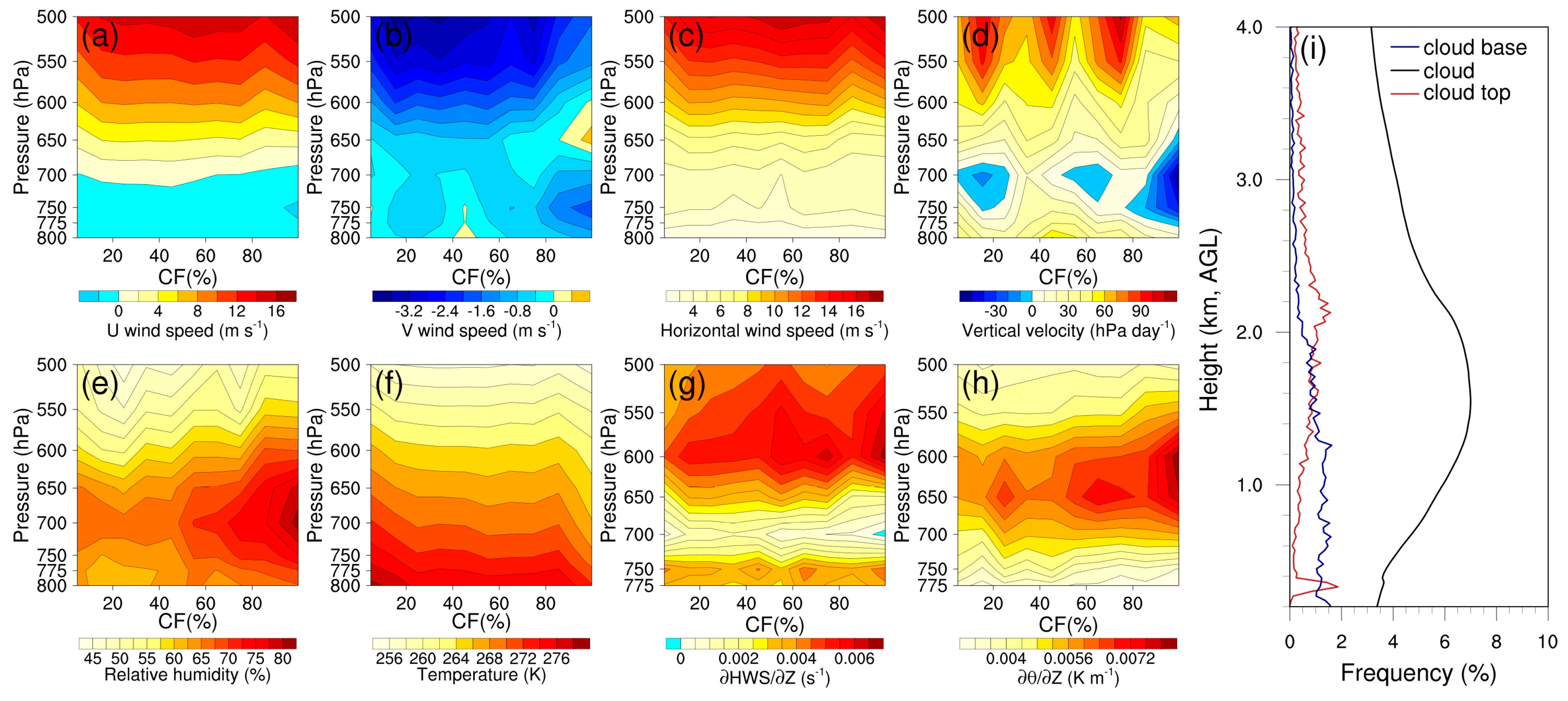
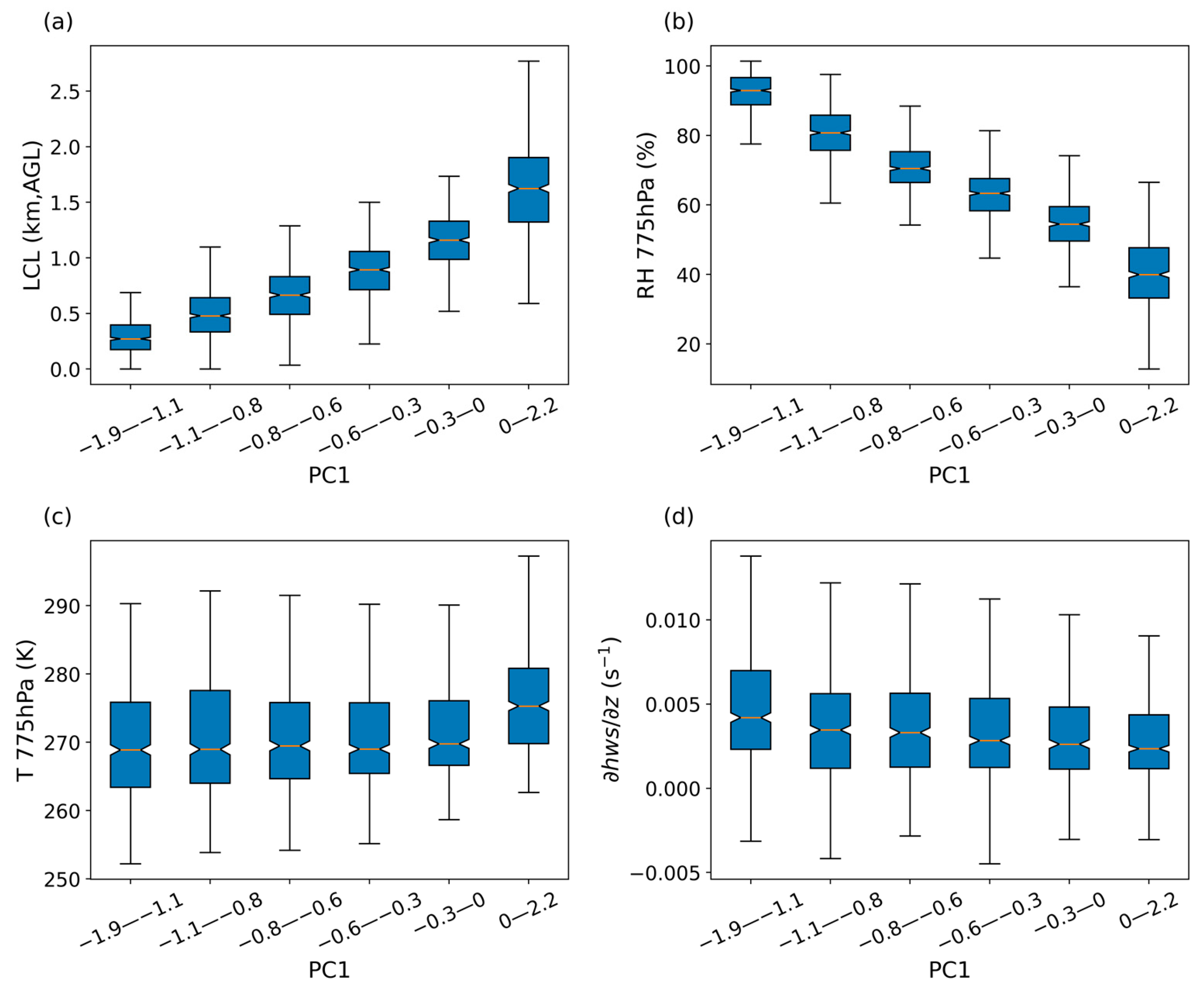
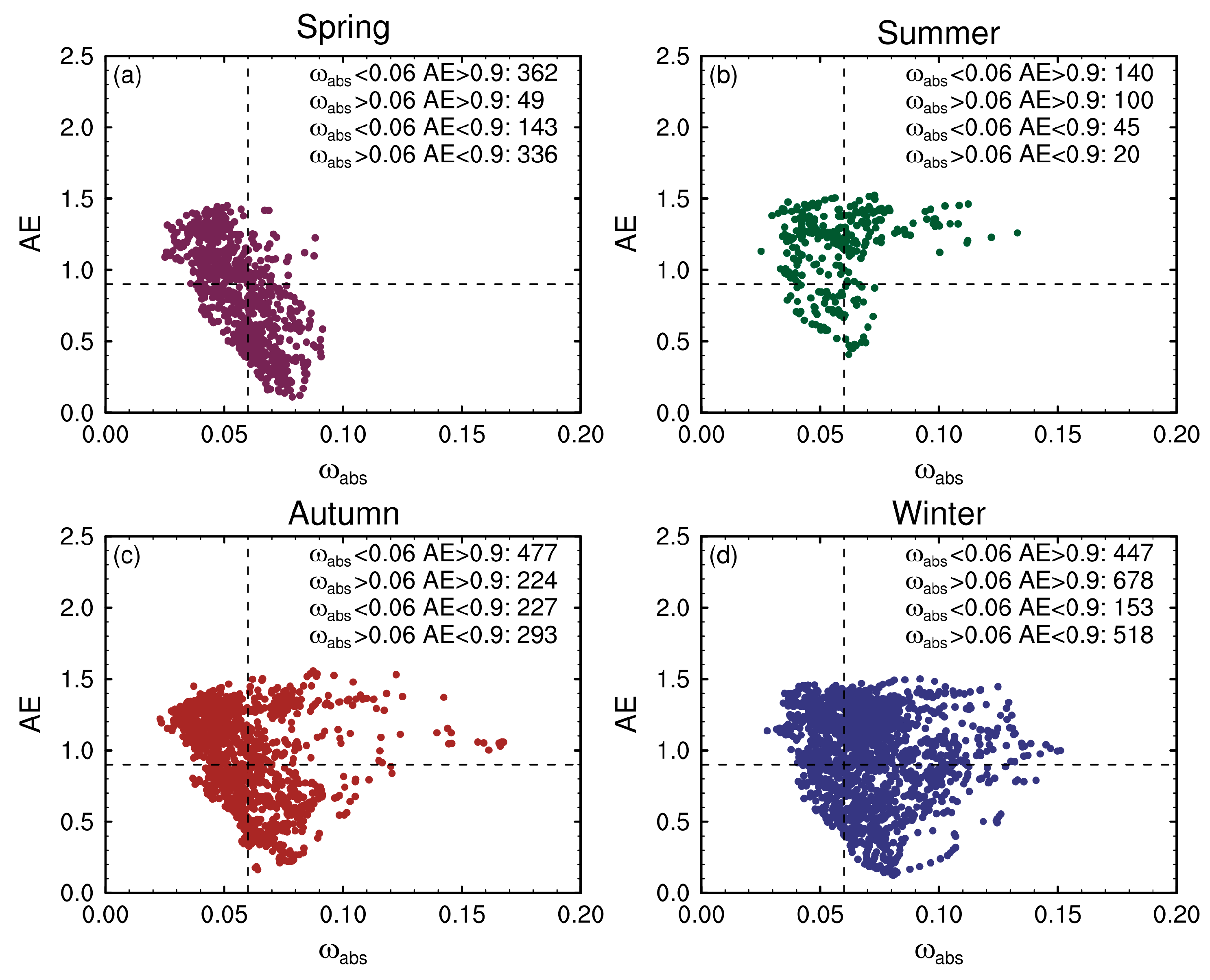

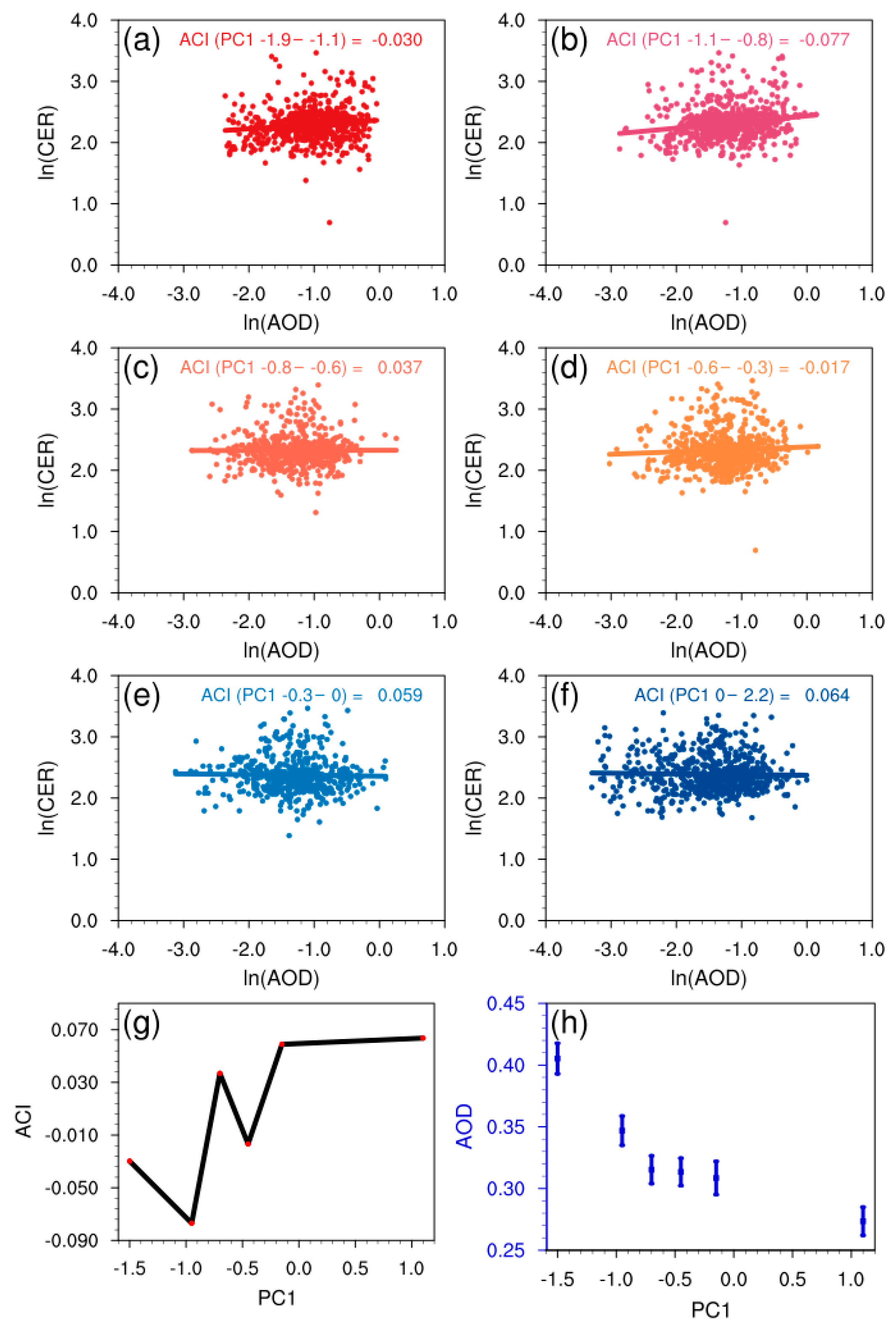
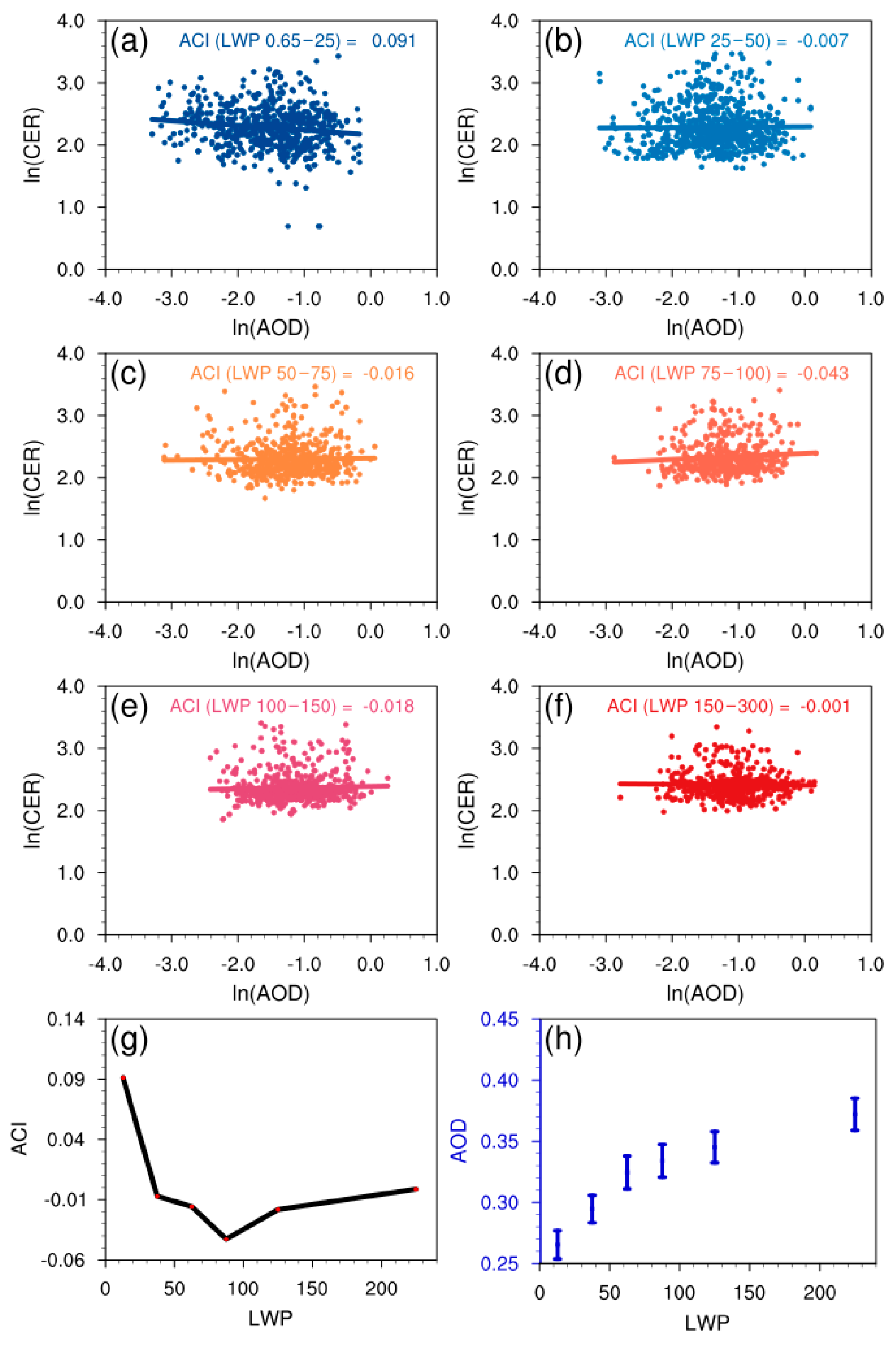
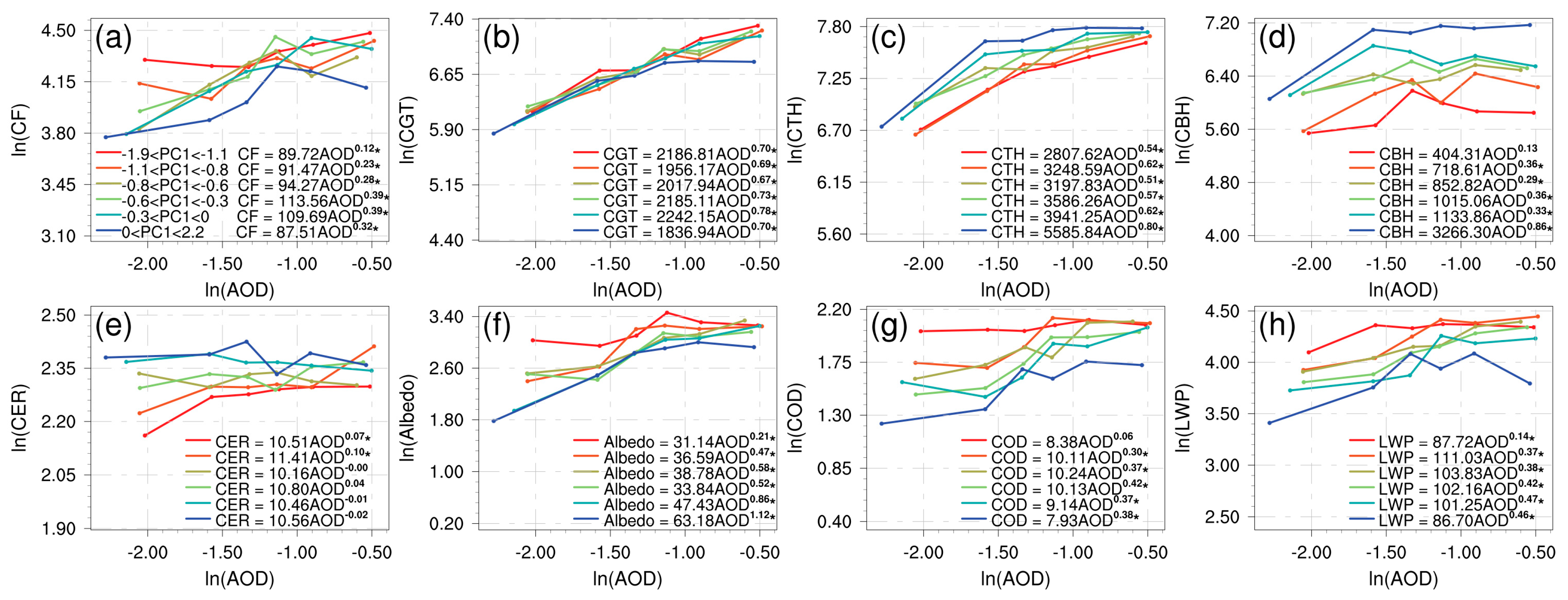
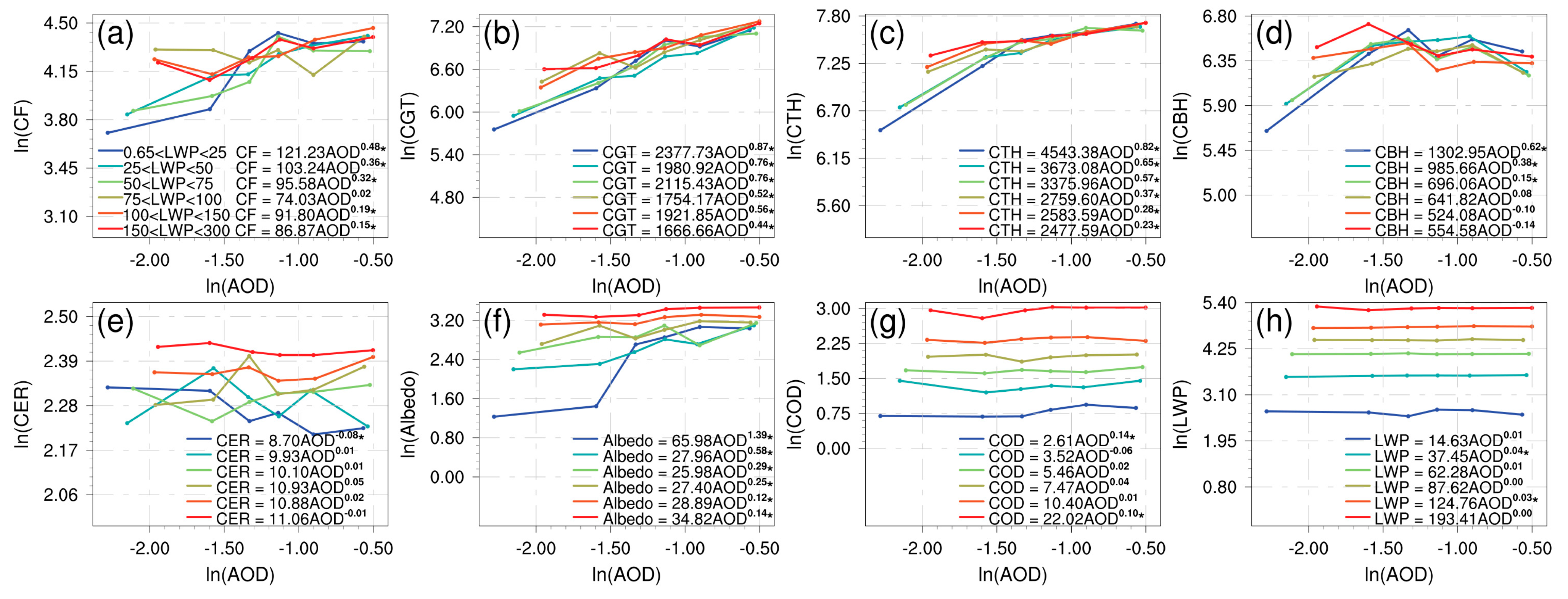
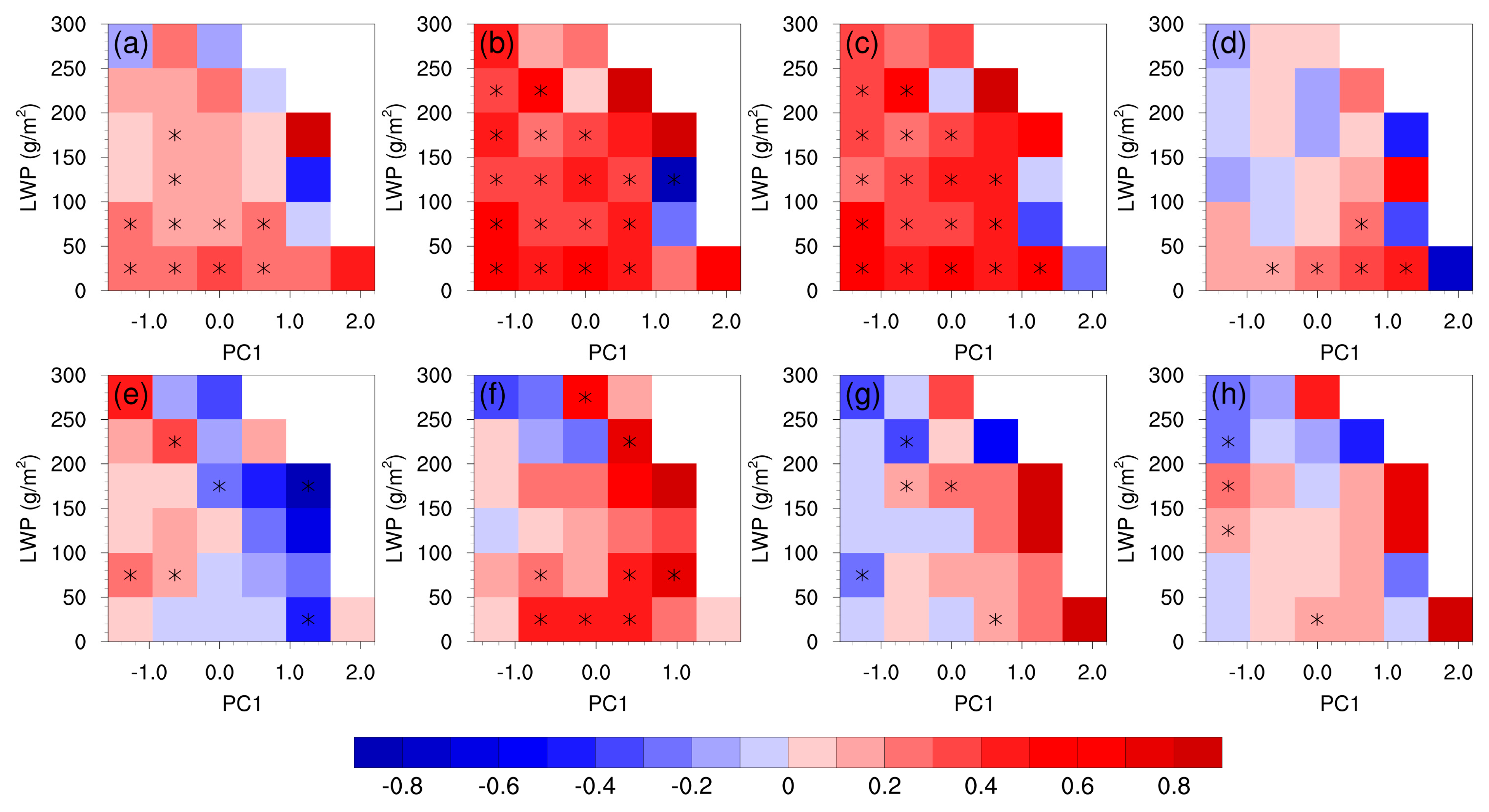
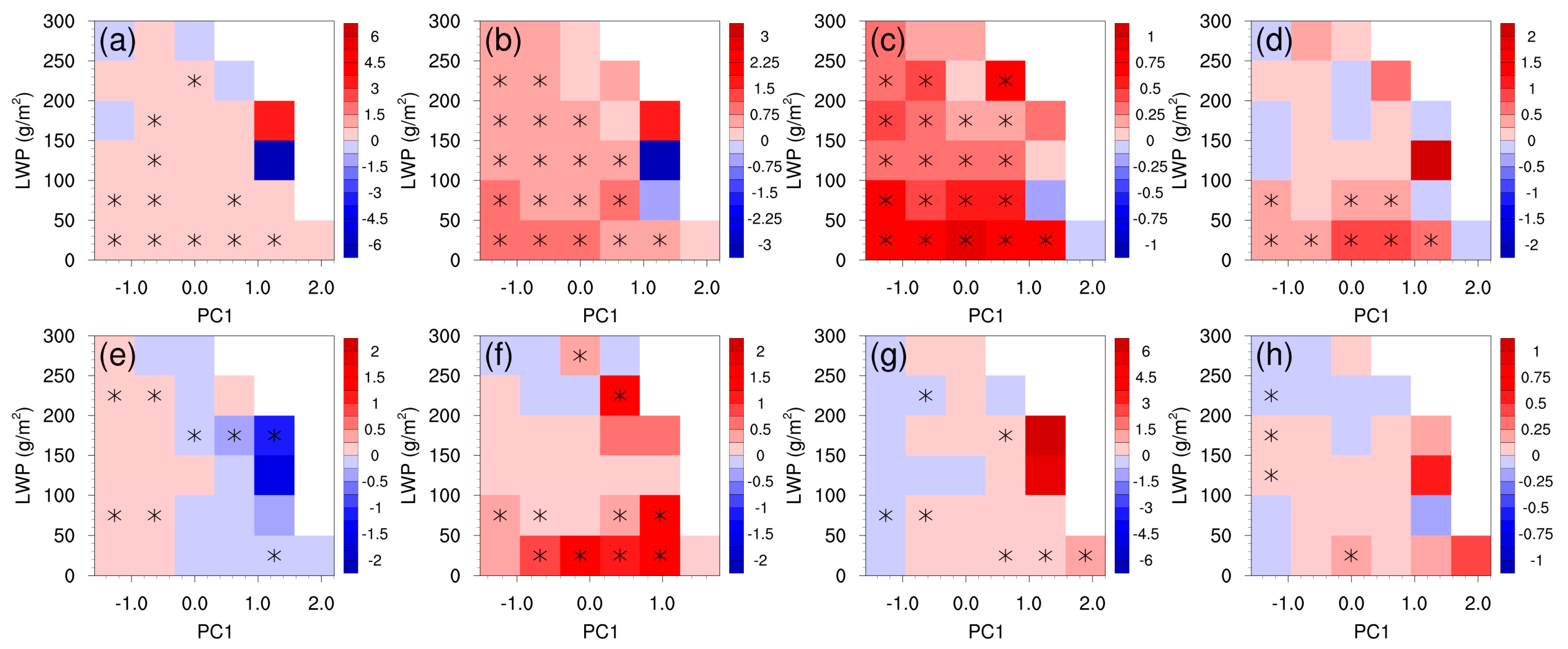
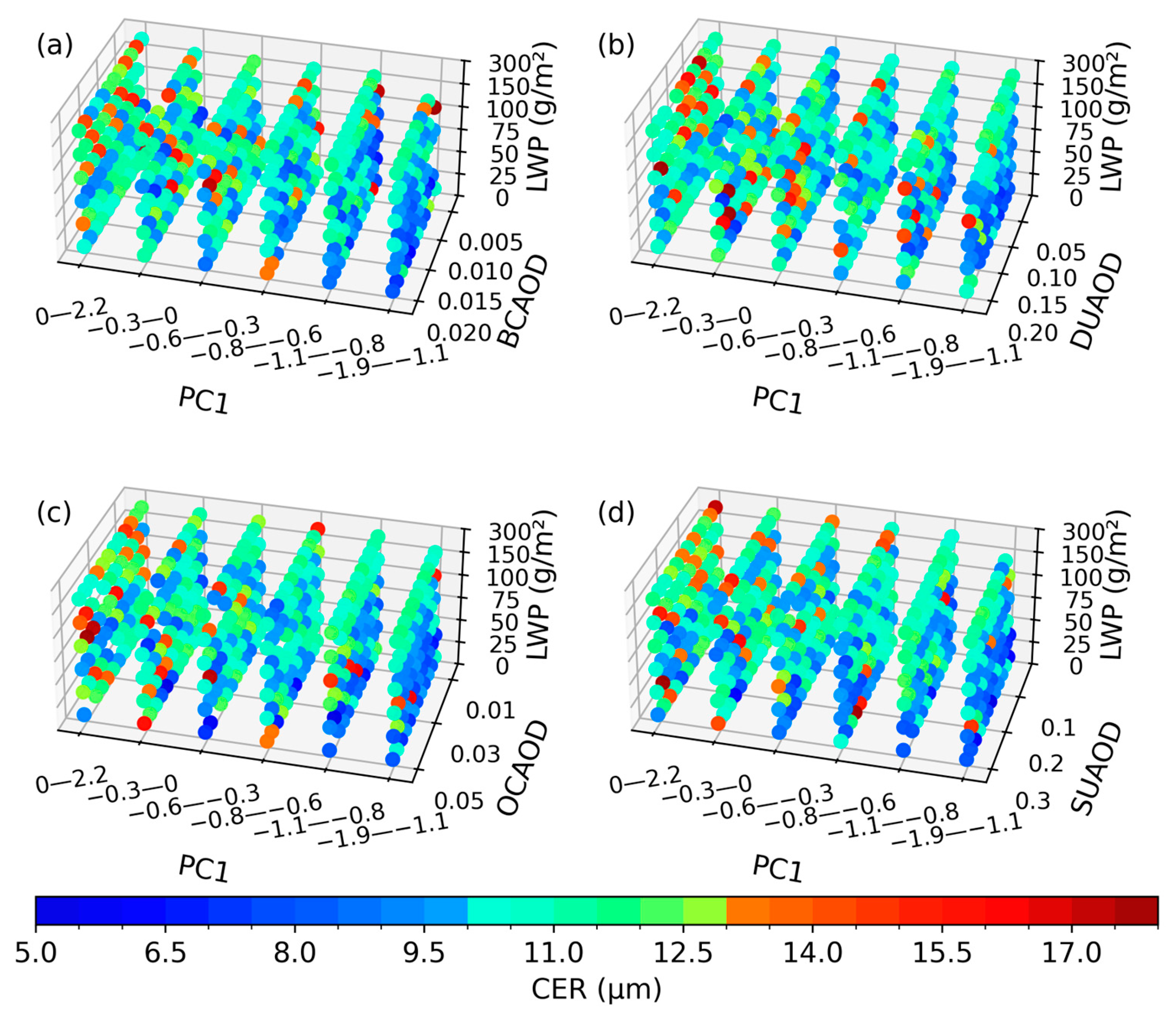
| Variables | CF | CGT | CTH | CBH | CER | LWP | COD | Albedo | MACC |
|---|---|---|---|---|---|---|---|---|---|
| LCL | 0.51 | 0.74 | 0.96 | 0.96 | 0.87 | 0.88 | 0.91 | 0.91 | 0.84 |
| RH | 0.87 | 0.93 | 0.76 | 0.80 | 0.50 | 0.92 | 0.82 | 0.94 | 0.82 |
| T | 0.79 | 0.28 | 0.80 | 0.91 | 0.85 | 0.95 | 0.96 | 0.91 | 0.80 |
| U | 0.67 | 0.69 | 0.86 | 0.80 | 0.45 | 0.83 | 0.83 | 0.91 | 0.76 |
| HWS | 0.56 | 0.78 | 0.89 | 0.81 | 0.36 | 0.72 | 0.72 | 0.83 | 0.71 |
| V | 0.81 | 0.83 | 0.76 | 0.53 | 0.72 | 0.67 | 0.69 | 0.67 | 0.71 |
| 0.73 | 0.79 | 0.88 | 0.83 | 0.47 | 0.52 | 0.59 | 0.53 | 0.67 | |
| ω | 0.66 | 0.83 | 0.80 | 0.57 | 0.53 | 0.62 | 0.57 | 0.69 | 0.66 |
| 0.70 | 0.66 | 0.66 | 0.43 | 0.49 | 0.70 | 0.62 | 0.70 | 0.62 |
| Pressure (hPa) | PC1-U | PC1-HWS | PC1-V | PC1- | PC1-ω | PC1- |
|---|---|---|---|---|---|---|
| 500 | 0.79 | 0.74 | 0.85 | 0.75 | 0.86 | 0.72 |
| 550 | 0.74 | 0.76 | 0.79 | 0.71 | 0.86 | 0.75 |
| 600 | 0.78 | 0.77 | 0.81 | 0.67 | 0.88 | 0.84 |
| 650 | 0.86 | 0.89 | 0.81 | 0.58 | 0.86 | 0.88 |
| 700 | 0.78 | 0.84 | 0.85 | 0.81 | 0.85 | 0.88 |
| 750 | 0.84 | 0.83 | 0.87 | 0.84 | 0.85 | 0.85 |
| 775 | 0.87 | 0.89 | 0.87 | 0.87 | 0.88 | 0.90 |
| 800 | 0.84 | 0.86 | 0.80 | 0.83 |
| Variables | CF | CGT | CTH | CBH | CER | LWP | COD | Albedo |
|---|---|---|---|---|---|---|---|---|
| LCL | −0.51 | −0.74 | 0.96 | 0.96 | 0.87 | −0.88 | −0.91 | −0.91 |
| RH775 hPa | 0.88 | 0.89 | −0.36 | −0.97 | −0.80 | 0.95 | 0.94 | 0.96 |
| T775 hPa | −0.92 | −0.13 | 0.89 | 0.96 | −0.85 | 0.93 | 0.96 | 0.87 |
| 0.69 | 0.83 | 0.88 | 0.79 | −0.54 | 0.46 | −0.16 | 0.57 | |
| PC1 | −0.89 | −0.91 | 0.77 | 0.97 | 0.85 | −0.95 | −0.91 | −0.95 |
Disclaimer/Publisher’s Note: The statements, opinions and data contained in all publications are solely those of the individual author(s) and contributor(s) and not of MDPI and/or the editor(s). MDPI and/or the editor(s) disclaim responsibility for any injury to people or property resulting from any ideas, methods, instructions or products referred to in the content. |
© 2025 by the authors. Licensee MDPI, Basel, Switzerland. This article is an open access article distributed under the terms and conditions of the Creative Commons Attribution (CC BY) license (https://creativecommons.org/licenses/by/4.0/).
Share and Cite
Li, Q.; Ge, J.; Li, Y.; Mu, Q.; Peng, N.; Su, J.; Wang, B.; Zhang, C.; Liu, B. Unraveling Aerosol and Low-Level Cloud Interactions Under Multi-Factor Constraints at the Semi-Arid Climate and Environment Observatory of Lanzhou University. Remote Sens. 2025, 17, 1533. https://doi.org/10.3390/rs17091533
Li Q, Ge J, Li Y, Mu Q, Peng N, Su J, Wang B, Zhang C, Liu B. Unraveling Aerosol and Low-Level Cloud Interactions Under Multi-Factor Constraints at the Semi-Arid Climate and Environment Observatory of Lanzhou University. Remote Sensing. 2025; 17(9):1533. https://doi.org/10.3390/rs17091533
Chicago/Turabian StyleLi, Qinghao, Jinming Ge, Yize Li, Qingyu Mu, Nan Peng, Jing Su, Bo Wang, Chi Zhang, and Bochun Liu. 2025. "Unraveling Aerosol and Low-Level Cloud Interactions Under Multi-Factor Constraints at the Semi-Arid Climate and Environment Observatory of Lanzhou University" Remote Sensing 17, no. 9: 1533. https://doi.org/10.3390/rs17091533
APA StyleLi, Q., Ge, J., Li, Y., Mu, Q., Peng, N., Su, J., Wang, B., Zhang, C., & Liu, B. (2025). Unraveling Aerosol and Low-Level Cloud Interactions Under Multi-Factor Constraints at the Semi-Arid Climate and Environment Observatory of Lanzhou University. Remote Sensing, 17(9), 1533. https://doi.org/10.3390/rs17091533






